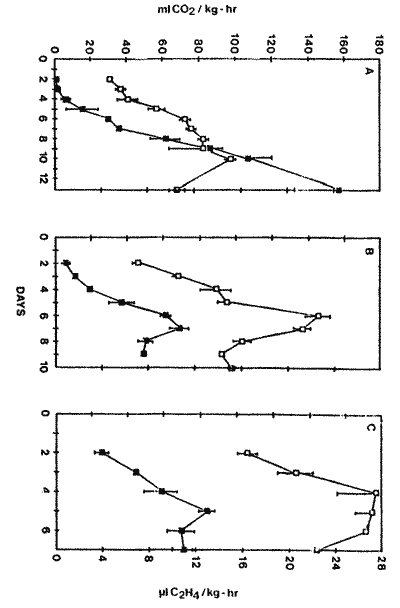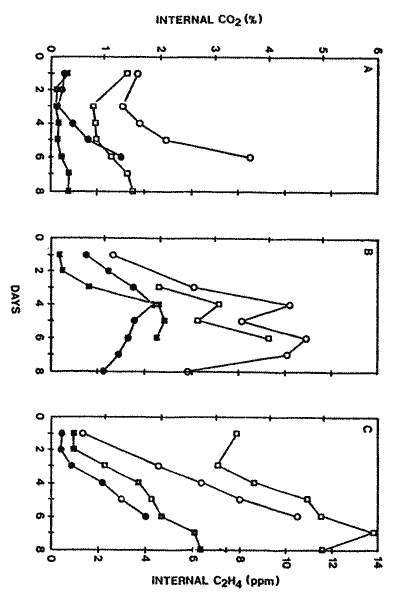
EFFECTS OF HARVEST MATURITY ON RESPIRATION, ETHYLENE PRODUCTION
AND
THE COMPOSITION OF INTERNAL ATMOSPHERES OF DURIAN
SCIENTIFIC NAME: Durio zibethinus
FAMILY: Bombacaceae
MATERIALS AND METHODS
'Chanee' durian fruit were obtained on 15 and 27 May, 1986 from a commercial orchard in Rayong Province, Thailand. Fruit were received in the Postharvest Technology Laboratory on the afternoon of the day of harvest. Fruit were categorized into 3 groups of maturity stages, 75, 85, and 95% based on market practices. Fruit weight varied from 2.1 to 3.1 kg each. The judgement of harvest maturity was assisted by an experienced grower based on a combination of criteria such as the number of days between full bloom to harvest and external rind characteristics. This was aligned with the number of days between harvest to respiratory peak measured in the laboratory. Fruit were kept in a room maintained at 22°C. Treatments were applied to fruit on the next day.
Measurements of respiration and ethylene production: Fruit of three different maturity stages at harvest were used. There were two fruit for each maturity stage. Individual fruit were placed in an 18-1 PVC respiration chamber at a constant temperature laboratory at 22°C and flushed continuously with humidified ethylene-free air (40 l/hr). A 1-ml gas sample was taken daily with a hypodermic syringe from the outflow of the chamber for the determination of CO2 evolution and ethylene production. CO2 was measured by a Shimadzu 9-A chromatograph equipped with a thermal conductivity detector and a Porapack R column. Ethylene was measured by a Shimadzy 9-A gas chromatograph equipped with a flame ionization detector and an activated alumina column. Results obtained were from 2 replicate fruit.
Internal gases sampling method: Fruit harvested at three different maturity stages were used. Daily monitoring of internal gases was made on the same fruit to avoid the variability existing between different fruit. There were two fruit for each maturity stage. Two sampling ports were made previously on the equatorial region of each fruit. This was done by the removal of a piece of rind 1.5 to 2 cm thick with a sterile 0.6 mm cork borer. Care was taken not to injure the aril. The hole was plugged with a short plastic tube of the same diameter sealed to the rind with synthetic rubber-cement. The outside end of the plastic tube was tightly plugged with a septum. Fruit were placed uncovered in the laboratory at 22°C. Gas sample was withdrawn through the septum by a 1-ml hypodermic syringe. CO2 and ethylene was determined by gas chromatography as mentioned previously.
RESULTS AND DISCUSSION
Fig.1 shows respiratory patterns and ethylene production of three groups of durians representing different stages of maturity at harvest. Rate of respiration at the pre-climacteric stage was higher for fruit harvested at a higher maturity stage. The respiratory climacteric peak was higher also for fruit harvested at a higher maturity stage. Days from harvest to respiratory climacteric peak were 9 to 10 days for fruit of 75% maturity. This was reduced to 6 and 3 days as fruit maturity at harvest advanced to 85 and 95% respectively. Distinct durian aroma which indicated the fruit was eating-ripe developed one day prior to the respiratory peaks. Ethylene production was higher for fruit of higher maturity stages. Ethylene production increased in parallel to CO2 evolution. Ethylene peak, accompanied by fruit senescence, occurred one day behind the respiratory peak. All fruits in 85 and 95% maturity groups were over-ripe by the end of the experiment. Fruit of 75% maturity were either of inferior eating quality or showed abnormal ripening.
Fig.2 indicates the levels of internal CO2 and ethylene of a representative fruit which had been harvested at different maturity stages.
Fruit of 75% would either fail to ripen or ripe unevenly. In an immature fruit that failed to ripen, there was a very slight or little increase in the internal CO2 and ethylene concentrations. Internal ethylene content averaged less than 0.5 ppm. The fruit was difficult to break open and the aril remained hard when the experiment ended after 8 days due to rotting. In an immature fruit that showed an uneven ripening, there was a climacteric rise in the CO2 and ethylene concentrations in the fruit as results of ripening. Internal CO2 increased from 1.5% to more than 3.5%. Internal ethylene levels at the pre-climacteric stage and the climacteric peak were about 0.5 and 3.1 ppm respectively. The quality of ripe fruit was inferior (Fig.2-A).
Fruit of more advanced maturity groups (85 and 95%) showed parallel increases and falls in internal CO2 and ethylene levels (Fig.2-B and C).
Initial ethylene concentrations inside the fruit ranged from 0.5 to 1.5 ppm. At ethylene climacteric peak, concentrations ranged 4.4 to 6.3 ppm. Fruit were over-ripe by the end of the experiment. The results indicate that despite an apparent climacteric rise in CO2 and ethylene production in fruit of 75% maturity, eating quality and other ripening parameters were inferior or abnormal.
Some fruits might not be able to initiate ripening. Based on market practice, 85% maturity is the most commonly-harvested stage. The fruit would ripen to excellent quality in less than a week. Harvesting of durian at a stage earlier than this optimum is not desirable. In fruit of 85 and 95% maturity, the onset of climacteric rise occurred almost without a pre-climacteric lag phase. The relative high rate of respiration and ethylene production in 95% maturity fruit indicated that ripening was well under way at harvest. Fruit harvested at such a stage became eating ripe on the second to third day after harvest.
The investigation also indicates the effects of maturity on the levels of internal CO2 and ethylene accumulated in durians at harvest and during ripening. It is likely that in some of the more advanced fruit, the onset of ripening occurred immediately upon harvest or had already began while the fruit is still on the tree. This would make ripening control of durian a very difficult task.
 |  |
| Fig.1. Respiration (a) and ethylene production rate (a) at 22°C of Durian cv.Chanee harvested at 75(A), 85(B) and 95%(C) maturity. Results were means ± SE of 2 replicate fruit. | Fig.2 - Internal CO2 (empty markers) and C2H4 (filled markers) levels at 22 °C of Durian cv. Chanee harvested at 75(A), 85(B) and 95%(C) of maturity. There were 2 fruit for each maturity stage. |
DATE: September 1989
* * * * * * * * * * * * *
